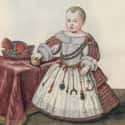-
(#3) Charles's Problems Were Apparent From Childhood
When Charles II was born in 1661, his parents must have thought he would not live long. Contemporary writings called the baby "big headed" and a "weak breast-fed baby." Charles did not speak until he turned four, and he was unable to walk until the age of eight. In spite of paintings that tried to show him as a healthy baby, Charles was weak and ailing from birth.
According to Jacques Sanguin, an envoy for King Louis XIV sent to confirm the baby's sex amid rumors that he was not a male heir, Charles "seems extremely weak, both cheeks have a herpes-type rash, the head is covered with scabs, and below the right ear a type of suppurating duct or drainage has formed."
Charles inherited the Spanish throne at the age of four when his father died. But even his own family doubted that he could ever rule alone - his mother became the boy's regent. Historian Stanley G. Payne described young Charles as a "pathetic prince,"and "the degenerate product of five generations of Spanish Habsburg inbreeding."
-
(#1) Most Of Charles's Health Issues Were Caused By Genetic Disorders
The Habsburg gene pool was even worse than that specific relation would indicate, because the family had generations of inbreeding leading to Charles II.
Two of Charles's great-grandfathers married their own nieces, while another married his first cousin. Because his parents were closely related, Charles was also his own mother's first cousin and his father's great-nephew. His grandmother was also his aunt. Charles's family tree traced back to a single couple: Philip and Joanna of Castile, who lived in the 16th century.
Charles likely suffered from two genetic disorders: combined pituitary hormone deficiency and distal renal tubular acidosis. The first, caused by a mutation in the gene necessary to produce hormones in the pituitary gland, was responsible for Charles's short stature, infertility, and impotence. It could also cause weak muscles and digestive problems.
The second, caused by a gene mutation, makes it difficult for the kidneys to get rid of acid through the urine. It can lead to bloody urine, weak muscles, and a large head relative to the size of the body.
-
(#2) Paintings Of A Healthy King Hid His Decrepit Body
Although painters tried to depict Charles II as a healthy, strong king, they hid the truth of the ruler's physical conditions. He suffered from epileptic seizures that grew increasingly worse as he got older, and he was constantly plagued by diseases including measles, rubella, a plethora of dental and bronchial infections, frequent diarrhea, and vomiting. He also had the famous Habsburg jaw. The jutting jaw made it nearly impossible for Charles to chew his food. According to a British envoy, Alexander Stanhope, Charles II, "swallows all he eats whole, for his nether jaw stands so much out, that his two rows of teeth cannot meet."
Charles married twice - first at the age of 18, and then at 29 - but was unable to have children either time, with one wife complaining that Charles was impotent. By his 30s, Charles reportedly looked like an old man. In 1698, French Ambassador Marques d'Harcourt wrote to Louis XIV, Charles had "swollen feet, legs, abdomen, face and sometimes even his tongue so that he can not speak" and was "so weak that he [could] not be out of bed for more than one or two hours."
He struggled so with so many physical ailments he garnered the title of "the Bewitched" and the reputation extended even after his death. The royal court performed a post-mortem examination. It was uncommon for most royals, but Charles II was a rare exception. According to the autopsy the Bewitched King had "a very small heart of the size of a grain of pepper, the lungs corroded, the intestines putrefactive and gangrenous, in the kidney three large stones, a single testicle as black as coal and his head full of water." The results may have been exaggerated, but it's demonstrative of his reputation among his contemporaries.
-
(#7) Charles's Untimely Death Plunged Europe Into War
It was clear that Charles was not going to live long, and he had no children of his own. So in 1700, Charles issued his last will and testament. In the document, Charles chose Philip, Duke of Anjou, as his successor. Philip was the grandson of Charles's sister, who had married Louis XIV of France. But instead of a smooth succession, Charles's death led to years of war.
Charles was the last of the Spanish Habsburgs, and because of Spain's rich empire, a number of other European powers wanted to seize the throne. In fact, before Charles was even dead the English, Dutch, and French were already debating how to carve up his empire.
The War of the Spanish Succession dragged on from 1701 until 1713, as the powerful French monarch Louis XIV fought against an alliance of the English, Dutch, and the Holy Roman Empire to put his grandson on the throne. The war killed more than a million people, and in the end put a French Bourbon on the Spanish throne.
-
(#6) Spain's Colonial Expansion Caused Economic And Political Strife
Charles inherited a massive empire that dated back to the 16th century, when his ancestor Charles V had ruled over Germany, Austria, the Netherlands, Spain, and an enormous amount of territory in the New World. His vast territories were described as "the empire on which the sun never sets."
Wealth poured into Spain through its major port city, Seville, which Cervantes described as "just the place to find adventure, for in every street and on every street corner there were more adventures than in any other place.” Spain's transatlantic fleet appeared twice a year carrying gold and silver along with exotic luxury goods like cocoa, pineapples, and chili peppers. But all of the Spanish Empire's wealth couldn't prevent the decline of the Habsburg monarchy.
Spain faced a long decline in the 17th century. While millions of pounds of silver flooded the country between 1580 and 1630, the mass amounts the Spanish empire brought into the European market caused extreme inflation for the Spanish currency. The monarchy took on enormous amounts of debt while funding a multitude of war efforts in both Europe and the Americas.
But poor leadership from the Habsburgs also contributed to the decline. Historian J.H. Elliot described the rule of Charles II in his book Imperial Spain: "This last pallid relic of a fading dynasty was left to preside over the inert corpse of a shattered monarchy, itself no more that a pallid relic of the great imperial past." The king was simply unable to rule his empire, which would never again reach the heights of the 16th century.
-
(#5) The Habsburgs Intended To Strengthen Their Line Of Succession
Inbreeding was common practice for Europe's royalty - it was known as royal intermarriage. And for two centuries, the Spanish Habsburgs married within their family to maintain their royal heritage. The vast majority of their marriages during the 16th and 17th centuries were between blood relatives.
The Habsburgs justified their inbreeding by claiming the practice strengthened lines of succession and helped secure political alliances. During an era when royal blood was considered substantially different from common blood, rulers wanted to marry other rulers - but sometimes there weren't many options outside of cousins. The practice of intermarriage, meant to insure the purity of the bloodline, brought a host of genetic ailments and deformities that destroyed the monarchy.
New Random Displays Display All By Ranking
About This Tool
Charles II of Spain was only 38 years old when he died in 1700. In fact, he had lots of health problems throughout the entire life that it is unexpected that he has lived so long. Charles II of Spain, the king of one of the largest empires in the world, could barely speak or walk, which all because his royal family was inbred.
The gene mutations and defects caused by the royal family's inbreeding, Charles II of Spain suffered from rickets and often had hallucinations. Because there was no heir after his death, Europe fell into a bloody war, and all countries were vying for his throne. The random tool lists 7 details about how his health problems destroyed his dynasty.
Our data comes from Ranker, If you want to participate in the ranking of items displayed on this page, please click here.
















